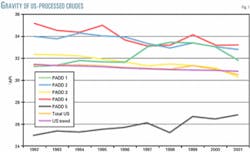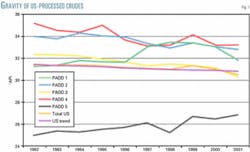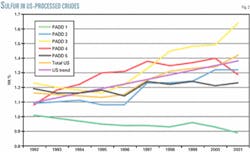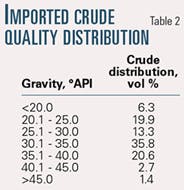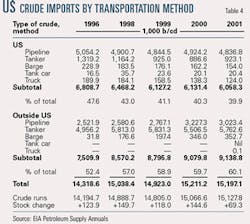The gravities of crude oils processed in US refineries have slowed from a previously rapid decrease in quality to a decrease of 0.07° API/year over the last 10 years. During the same period, there was a moderate increase in sulfur content of the lower-quality crudes, about 0.032 wt %/year.
The US Energy Information Administration (EIA) began reporting monthly and yearly composite values of ºAPI and sulfur content of crude oils processed within five Petroleum Administration for Defense Districts (PADDs) 18 years ago. Table 1 shows the latest 10-year (1992-2001) historical composite values of API gravity and sulfur content of crude oils processed by refineries in the five PADDs. For a diagram of PADDs, see OGJ, July 30, 2001, p. 62.
This article updates a previous one on gravity and sulfur contents of crudes (OGJ, Mar. 13, 2000) and contains 10 years of data including 2001 information.
A review of historical data for crude oil gravity and sulfur content indicated any trends in crude oil quality that would indicate poorer-quality crudes.
Table 1 and Figs. 1 and 2 present API gravity and sulfur data for all PADDs and the entire US for the past 10 years.
These factors determine crude oil quality processed in US refineries:
- Crude types available, whether from domestic or foreign sources.
- Refinery configuration, whether they can handle crude oil quality variations.
- Crude-quality price structure.
- Marketable product slate, whether it can give reasonably good refinery operating margins.
PADD 1
Refineries operating in PADD 1 increased the use of foreign crude oils to 98% in 2001 from a low of just over 80% in the early 1980s.
East Coast refineries are light, sweet-crude processors that mainly produce light transportation products for local consumption. Refinery owners are reluctant to invest in bottom-of-the-barrel conversion units to handle heavy crude oils. Also, East Coast refiners continue to process reasonable-quality crude oils due to the availability of light, sweet crudes at small marginal costs vs. poor-quality crudes.
These management decisions resulted in a mild increase of 0.19° API/year between 1992 and 2001. During this period, the sulfur content decreased by 0.01 wt %/year. Crude oil quality trends over the 1997-2001 time period indicate that gravity decreased by 0.28° API/year and sulfur content continued to decrease by 0.10 wt %/year.
Crude gravity processed by PADD 1 refiners declined by 1.17° API in 2001 vs. 2000. This decline may result from a decrease in foreign oil receipts of 64,000 b/cd and a mild switch from high gravity, low-sulfur crudes to moderate gravity, low-sulfur crudes.
Here are a few important statistics for PADD 1 refineries in 2001:
Crude runs were 1.499 million b/cd, a decrease of 72,000 b/cd from 2000 crude runs. The decrease was mainly due to the refineries operating at lower rates, about 87.2% of operable capacity, which was a result of decreased product demand after the events of Sept. 11, 2001.
Refinery crudes processed had a composite gravity of 31.83° API and a sulfur content of 0.89 wt %.
Foreign crude oil receipts were 1.478 million b/cd, a decrease of 64,000 b/cd from the 2000 level.
The top six imported crudes were from Nigeria (303,000 b/cd), Saudi Arabia (191,000 b/cd), Angola (171,000 b/cd), Norway (160,000 b/cd), Venezuela (143,000 b/cd), and Gabon (131,000 b/cd).
Domestic crudes include those from New York, Pennsylvania, Virginia, and West Virginia, as well as several Eastern states in PADD 2. Foreign crudes account for about 98% of crude, nearly 82% of which are received in tankers.
PADD 2
Refineries in PADD 2 increased imports of foreign crude oils to 48% in 2001 from the low 20% range in the mid-1980s. Crude quality dropped off moderately during the past 10 years, a decrease of 0.14° API/year, but with a moderate increase in sulfur content, 0.029 wt %/year.
Crude quality trends during the last 5-year period slightly improved with a decrease in gravity of 0.10° API/year, but the sulfur increased 0.027 wt %/year. This is due to increased use of imported medium gravity, medium-sulfur crudes vs. a mix of higher gravity, lower-sulfur crudes during the past 5 years.
Important statistics for PADD 2 refineries in 2001 include:
Crude runs were 3.303 million b/cd, a decrease of 70,000 b/cd from 2000 crude runs.
Refineries operated at 93.9% of operable capacity.
Crudes processed had a composite gravity of 32.78° API and a sulfur content of 1.32 wt %.
Refiners imported foreign crudes at a rate of 1.557 million b/cd, an increase of 28,000 b/cd vs. 2000 imports.
Top six imported crudes into PADD 2 were from Canada (962,000 b/cd), Saudi Arabia (193,000 b/cd), Nigeria (110,000 b/cd), Iraq (85,000 b/cd), Venezuela (52,000 b/cd), and the UK (37,000 b/cd).
Domestic crude receipts decreased slightly to nearly 50% in year 2001 from the mid-50% range because domestic crude oil production fell in the mid-central states. Nearly all domestic crudes are shipped to PADD 2 refineries through pipelines.
Although refiners report that all imported foreign crudes are received via pipeline, this is done to avoid double counting. An offshore terminal on the Gulf Coast receives imports (excluding Canadian crudes) via tanker then pipelines them to the refineries.
PADD 3
Refineries operating in PADD 3 increased their use of foreign crude imports to nearly 70% in 2001 from the upper 20% range in the mid-1980s. Crude quality dropped off quickly in the 10-year period between 1992 and 2001, by 0.20° API/year. Sulfur content increased by 0.05 wt %/year during the same period.
Between 1997 and 2001, crude quality decreased by 0.24° API/year and sulfur increased by 0.066 wt %/year.
Crude production in PADD 3 hit a low of 3.12 million b/cd in 1995 and has increased to a rate of 3.271 million b/cd in 2001. PADD 3 refiners, however, must still import more foreign crudes to meet increased crude runs.
There are five joint ventures between US and other countries in the PADD 3 Gulf Coast region.
Crudes from Mexico, Saudi Arabia, and Venezuela are major sourcing countries to these five joint-venture operations.
These crudes have a medium-heavy API gravity and medium sulfur content, which significantly impacted the average crude characteristics processed in PADD 3 refineries. The joint venture refineries are modifying their equipment to process crude oils from Mexico and Venezuela, which should continue the trend of lower API gravity and moderate sulfur content.
Important statistics for PADD 3 refineries in 2001 include:
Crude runs increased by 139,000 b/cd to 7.278 million b/cd in 2001.
Refineries operated at 94.8% of capacity.
Crudes processed had a composite gravity of 30.32° API and average sulfur content of 1.64 wt %.
Imports increased by 228,000 b/cd to a total of 5.354 million b/cd in 2001.
The top six foreign crude oils imported were from Mexico (1.288 million b/cd), Saudi Arabia (1.109 million b/cd), Venezuela (1.079 million b/cd), Iraq (545,000 b/cd), Nigeria (427,000 b/cd), and Kuwait (214,000 b/cd).
Domestic crude receipts gradually fell to about 30% in 2001 from the mid-30% range in 1996 due to lower crude production in the lower South Central states. Pipelines transported more than 90% of domestic crudes to PADD 3 refineries.
About 77% of foreign crude imports come directly to Gulf Coast refineries via tankers. The remainder of imports come in via tankers at Gulf Coast receiving terminals and are then transferred to inland refineries via pipeline.
PADD 4
Refineries operating in PADD 4 are isolated from imports other than Canadian crudes. Refineries process crudes from Colorado, Montana, Utah, and Wyoming. Rocky Mountain refineries' crude mix is 41.0% Canadian crudes, an increase from 10% in the mid-1980s.
Crude quality decreased moderately during 1992-2001, about 0.21° API/year, with a moderate increase in sulfur content, 0.027 wt %/year.
Crude-quality trends in the 5-year period between 1997 and 2001 differed significantly from the 10-year trends.
Crude quality stabilized between 33.30 and 33.39, creating a rate change of less than 0.02° API/year.
The increase in sulfur rate slowed to 0.013 wt %/year from 0.027 wt %/year.
High gravity, low-sulfur crude production in PADD 4 states has dropped off about 18,000 b/cd-year in the past 5 years.
This loss of high-quality domestic crudes is being replaced by Canadian crude imports. The decrease in API gravity and increase in sulfur levels of crude oils processed in PADD 4 should therefore continue.
Important statistics for PADD 4 refineries in 2001 include:
Crude runs were 500,000 b/cd, a decrease of 5,000 b/cd from 2000 crude runs.
Refineries operated at 90.7% of capacity.
Crudes had a composite gravity of 33.19° API and a sulfur content of 1.29 wt %.
Refineries imported 195,000 b/cd from Canada, an increase of 26,000 b/cd vs. 2000 levels.
Domestic crude receipts fell to about 60% in 2001 from the mid-70% range in 1996 due to a decline in domestic crude oil production in Rocky Mountain states.
More than 90% of the domestic crude oils was shipped to refineries via pipelines. Remaining domestic crudes arrived at the regional refineries in trucks.
PADD 5
Refineries operating in PADD 5 increased the amount of imported crudes to more than 28% in 2001 from about 14% in 1980. Crudes processed in this region had an API gravity averaging about 25.81° API during the past 10 years; annual values varied between a high of 26.82° API in 2001 to a low of 24.95° API in 1992.
API gravities have increased by 0.19° API/year during the 10 years from 1992 to 2001. Crude sulfur content increased moderately by 0.008 wt %/year. During the 5-year period from 1997 to 2001, API gravity increased by 0.27° API/year and the sulfur content has decreased slightly by 0.003 wt %/year.
Because crude production in PADD 5 has decreased by 116,000 b/cd/year during the past 5 years, refiners need to import more crude to meet refinery requirements. The fall in crude production is mainly from Alaskan North Slope (ANS) fields, about 83,000 b/cd. No Alaskan crudes were shipped to other PADD districts nor exported in 2001.
Two refineries in Hawaii process crude oils from the Pacific Rim, Middle East, and some ANS. Pacific Northwest refiners use ANS and Canadian crude oils. California refineries process crudes from California and ANS. California crudes are of a rather poor quality: 25.0-26.0° API and sulfur of 1.05-1.10 wt %.
Iraq, Canada, and Saudi Arabia are major importers to PADD 5. Because foreign crudes currently account for more than 28% of crude runs, these medium gravity, medium-sulfur crudes improve overall crude quality in PADD 5.
Important statistics for PADD 5 refineries in 2001 include:
Crude runs increased 68,000 b/cd to 2.547 million b/cd.
Refineries operated at 89.1% of capacity.
Crudes processed had a composite gravity of 26.82° API and a sulfur content of 1.23 wt %.
Foreign crude oil receipts increased 41,000 b/cd to 746,000 b/cd.
The top six imported crudes came from Iraq (152,000 b/cd), Saudi Arabia (118,000 b/cd), Canada (77,000 b/cd), Ecuador (66,000 b/cd), Mexico (50,000 b/cd), and Indonesia (40,000 b/cd).
Alaskan crude oil receipts were 999,000 b/cd, a 0.3% decrease from 2000.
Domestic crude receipts fell to about 72% in 2001 from 85% in 1996 due to lower production levels in California and ANS regions. California crudes are shipped to refineries by pipeline and ANS crude is shipped via tankers. All foreign crudes enter refineries in California and Hawaii by tankers.
EIA had no comment about why stock changes were at least 100,000 b/cd in the past 5 years. Stock changes indicate the difference between crude oil receipts and crude oil runs.
Total US
The quality of crudes processed in the US has slowed to a decline of only 0.07° API/year in 2001 from a rapid decrease in 1992. Sulfur content has moderately increased to about 0.032 wt %/year over this 10-year period.
Crude quality in the 5-year period between 1997 and 2001 nearly doubled from the 10-year rate, a decline of 0.12° API/year. Sulfur content for this period has increased slightly, at 0.037 wt %/year.
These changes suggest that imported crudes replacing the decreasing domestic production have lower gravities and slightly higher sulfur content.
In 1997, imported crudes averaged about 8.225 million b/cd, whereas 2001 imported crudes averaged about 9.328 million b/cd; the increase a direct result of decreasing domestic crude production.
Table 2 shows the distribution of imported crudes according to gravity for the past 5 years.
Crude imports should follow a similar distribution in the near term. During the next 5-10 years, however, imports may include more heavier crudes due to:
A worldwide increase in crude demand, mainly in Pacific Rim countries.
Price spreads in crude oil grades by ºAPI.
Political stability of crude producing countries.
Decreased production of high gravity, low-sulfur crudes.
The top six countries that imported crude to the US in 2001 were Saudi Arabia (1.611 million b/cd), Mexico (1.394 million b/cd), Canada (1.356 million b/cd), Venezuela (1.291 million b/cd), Nigeria (842,000 b/cd) and Iraq (795,000 b/cd). These six countries supplied 78.1% of the imported crude oils in 2001.
The US imported crude from 35 different countries in 2001. Table 3 shows a 5-year history of major foreign crude oils imported into the US.
Iraq exported about 1.855 million b/cd of crude in 2001, 42.9% of which was imported into the US—a significant amount for a recent and future US enemy.
Some day the US will import Iranian crude oils.
Table 4 lists US receipts of crude according to transportation method. Domestic crude receipts gradually fell to about 40% in 2001 from about 47% in 1996. Refineries receive about 80% of domestic crudes by pipeline.
Foreign crude receipts have increased to about 60% in 2001 from 52% in 1996.
When US refinery crude runs increase and domestic crude production falls off, the crude deficit is supplied by greater quantities of imported crude oils.
Pipelines deliver the majority of Canadian crudes and some Mexican crudes. Other Canadian and Mexican crude oils, and all other offshore crude oils, are shipped via tanker to coastal refineries and coastal crude receiving terminals. Crudes at these terminals then transfer to inland refineries via pipelines.
The author
Edward J. Swain is an independent consultant in Houston. He is retired from Bechtel Corp., where he was a process planning engineer. Before joining Bechtel, he worked for UOP LLC and Velsicol Chemical Corp. Swain holds a BS in chemical engineering and an MS in business and engineering administration, both from the Illinois Institute of Technology, Chicago.
